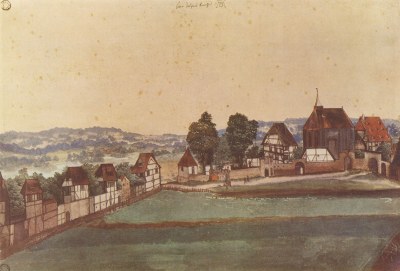Albrecht Dürer (1471–1528), Church and Churchyard of St. John near Nuremberg

From the end of the Middle Ages, a hospital suburb surrounded by gardens of wealthy citizens and patricians developed around Nuremberg's St. John leprosy hospital, first mentioned in 1234, and its cemetery. The district also included Holy Cross pilgrims' hospital, the St. Sebastian plague hospital, and a so-called French house for syphilis patients. The cemetery of St. John's served as a plague cemetery from 1517 and as a regular cemetery of the old town of Sebald from 1526, where Albrecht Dürer was also buried in April 1528.
Albrecht Dürer (1471–1528), Kirche und Kirchhof von Sankt Johann bei Nürnberg, ca. 1494; source: © Kunsthalle Bremen – Kupferstichkabinett, Inv.-Nr. Kl 33, war loss, http://www.kunsthalle-bremen.de/.